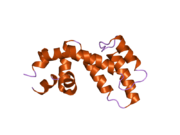Biology:RGS3
From HandWiki
Revision as of 13:41, 24 November 2021 by imported>John Stpola (fix)
 Generic protein structure example |
Regulator of G-protein signaling 3 is a protein that in humans is encoded by the RGS3 gene.[1][2][3]
This gene encodes a member of the regulator of G-protein signaling (RGS) family. This protein is a GTP-ase activating protein which inhibits G-protein mediated signal transduction. The protein is largely cytosolic, but G-protein activation leads to translocation of this protein to the plasma membrane. A nuclear form of this protein has also been described, but its sequence has not been identified. Multiple alternatively spliced transcript variants have been described for this gene but the full-length nature of some transcripts is not yet known.[3]
References
- ↑ "Inhibition of G-protein-mediated MAP kinase activation by a new mammalian gene family". Nature 379 (6567): 742–6. May 1996. doi:10.1038/379742a0. PMID 8602223. Bibcode: 1996Natur.379..742D. https://zenodo.org/record/1233178.
- ↑ "C2PA, a new protein expressed during mouse spermatogenesis". FEBS Lett 480 (2–3): 249–54. Nov 2000. doi:10.1016/S0014-5793(00)01942-6. PMID 11034339.
- ↑ 3.0 3.1 "Entrez Gene: RGS3 regulator of G-protein signalling 3". https://www.ncbi.nlm.nih.gov/sites/entrez?Db=gene&Cmd=ShowDetailView&TermToSearch=5998.
Further reading
- "Oligo-capping: a simple method to replace the cap structure of eukaryotic mRNAs with oligoribonucleotides". Gene 138 (1–2): 171–4. 1994. doi:10.1016/0378-1119(94)90802-8. PMID 8125298.
- "Genomic organization, 5'-flanking region, and chromosomal localization of the human RGS3 gene". Genomics 45 (2): 429–33. 1998. doi:10.1006/geno.1997.4929. PMID 9344672.
- Suzuki Y; Yoshitomo-Nakagawa K; Maruyama K et al. (1997). "Construction and characterization of a full length-enriched and a 5'-end-enriched cDNA library". Gene 200 (1–2): 149–56. doi:10.1016/S0378-1119(97)00411-3. PMID 9373149.
- Dulin NO; Sorokin A; Reed E et al. (1999). "RGS3 Inhibits G Protein-Mediated Signaling via Translocation to the Membrane and Binding to Gα11". Mol. Cell. Biol. 19 (1): 714–23. doi:10.1128/MCB.19.1.714. PMID 9858594.
- Dulin NO; Pratt P; Tiruppathi C et al. (2000). "Regulator of G protein signaling RGS3T is localized to the nucleus and induces apoptosis". J. Biol. Chem. 275 (28): 21317–23. doi:10.1074/jbc.M910079199. PMID 10749886.
- Shi CS; Lee SB; Sinnarajah S et al. (2001). "Regulator of G-protein signaling 3 (RGS3) inhibits Gbeta1gamma 2-induced inositol phosphate production, mitogen-activated protein kinase activation, and Akt activation". J. Biol. Chem. 276 (26): 24293–300. doi:10.1074/jbc.M100089200. PMID 11294858.
- "Ephrin-B reverse signaling is mediated by a novel PDZ-RGS protein and selectively inhibits G protein-coupled chemoattraction". Cell 105 (1): 69–79. 2001. doi:10.1016/S0092-8674(01)00297-5. PMID 11301003.
- Mittmann C; Schüler C; Chung CH et al. (2001). "Evidence for a short form of RGS3 preferentially expressed in the human heart". Naunyn Schmiedebergs Arch. Pharmacol. 363 (4): 456–63. doi:10.1007/s002100000376. PMID 11330340.
- Niu J; Scheschonka A; Druey KM et al. (2002). "RGS3 interacts with 14-3-3 via the N-terminal region distinct from the RGS (regulator of G-protein signalling) domain". Biochem. J. 365 (Pt 3): 677–84. doi:10.1042/BJ20020390. PMID 11985497.
- Kehrl JH; Srikumar D; Harrison K et al. (2002). "Additional 5' exons in the RGS3 locus generate multiple mRNA transcripts, one of which accounts for the origin of human PDZ-RGS3". Genomics 79 (6): 860–8. doi:10.1006/geno.2002.6773. PMID 12036301. https://zenodo.org/record/1229820.
- Ikeda M; Okai M; Miyoshi T et al. (2003). "Transcriptional suppression of the estrogen receptor by truncated estrogen receptor-alpha". Horm. Metab. Res. 34 (8): 425–30. doi:10.1055/s-2002-33599. PMID 12198596.
- "C2PA is a nuclear protein implicated in the heat shock response". J. Cell. Biochem. 87 (1): 65–74. 2003. doi:10.1002/jcb.10279. PMID 12210723.
- Strausberg RL; Feingold EA; Grouse LH et al. (2003). "Generation and initial analysis of more than 15,000 full-length human and mouse cDNA sequences". Proc. Natl. Acad. Sci. U.S.A. 99 (26): 16899–903. doi:10.1073/pnas.242603899. PMID 12477932.
- Ota T; Suzuki Y; Nishikawa T et al. (2004). "Complete sequencing and characterization of 21,243 full-length human cDNAs". Nat. Genet. 36 (1): 40–5. doi:10.1038/ng1285. PMID 14702039.
- Humphray SJ; Oliver K; Hunt AR et al. (2004). "DNA sequence and analysis of human chromosome 9". Nature 429 (6990): 369–74. doi:10.1038/nature02465. PMID 15164053. Bibcode: 2004Natur.429..369H.
- "Single-cell imaging of intracellular Ca2+ and phospholipase C activity reveals that RGS 2, 3, and 4 differentially regulate signaling via the Galphaq/11-linked muscarinic M3 receptor". Mol. Pharmacol. 66 (6): 1453–64. 2005. doi:10.1124/mol.104.005827. PMID 15383626.
- Gerhard DS; Wagner L; Feingold EA et al. (2004). "The Status, Quality, and Expansion of the NIH Full-Length cDNA Project: The Mammalian Gene Collection (MGC)". Genome Res. 14 (10B): 2121–7. doi:10.1101/gr.2596504. PMID 15489334.
- Rual JF; Venkatesan K; Hao T et al. (2005). "Towards a proteome-scale map of the human protein-protein interaction network". Nature 437 (7062): 1173–8. doi:10.1038/nature04209. PMID 16189514. Bibcode: 2005Natur.437.1173R.



